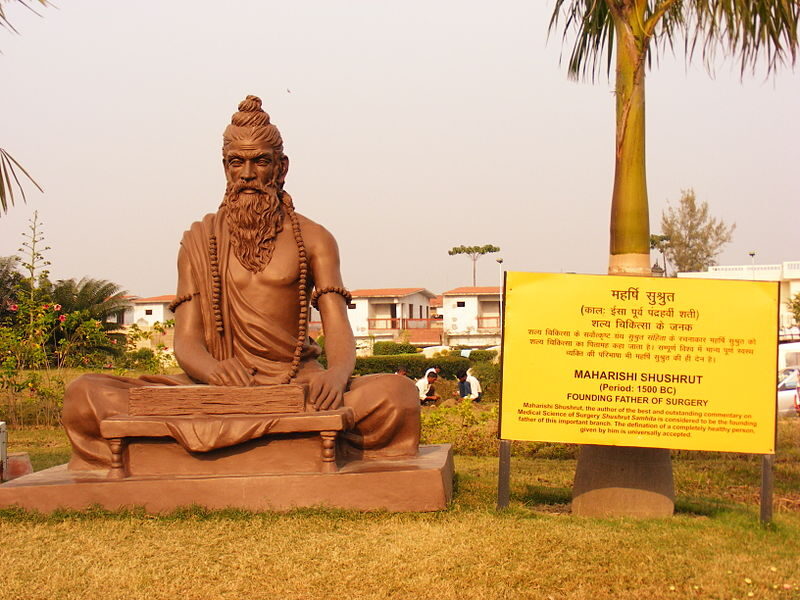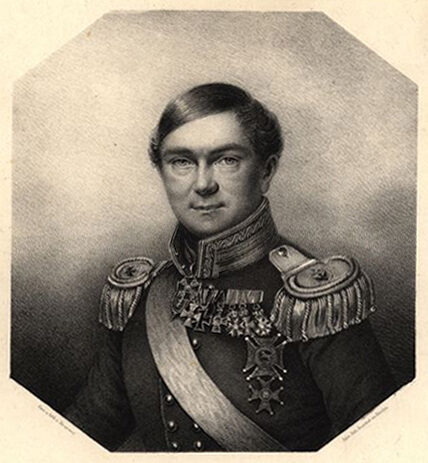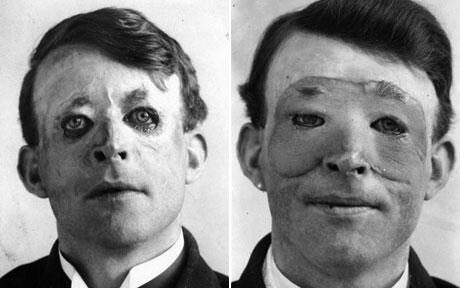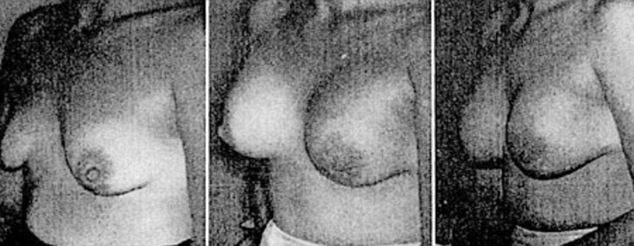The Daily Mail recently ran an article regarding the increasing number of people who were hoping for a surgical gift last Christmas. Reports showed a dramatic 35% increase in requests for cosmetic procedures in New York alone. Now I don’t know about you, but this seems like a significant increase over the course of one year. It really got me thinking about where this trend even started, or if it is even a trend at all? Has it been around for years, but people were just a little more hush-hush about going under the knife? Well, fancy my surprise when my research took me back to Ancient Egypt…
Roots in Rhinoplasty
Believe it or not the earliest known Rhinoplasties (or ‘Nose Job’) was first mentioned in an Ancient Egyptian medical text known as the Edwin Smith Papyrus. This text is the oldest known surgical treatise, dating back to the Old Kingdom of 3000 to 2500 BC. However, don’t go thinking the ancient world was full of image conscious Pharaohs with nose complexes. You could make as many herbal teas as you want to calm your patient’s nerves, but without anesthetic you can imagine this procedure would have hurt a lot. You would have had to have one seriously vain ruler to have gone through that pain to just to remove their ski-slope. It is more than likely Rhinoplasties were only carried out on people with real medical conditions, such as respiratory impediments. 
The Edwin Smith papyrus: the world’s oldest surviving surgical document.
Source: Wikipedia DID YOU KNOW: Infection from surgery was reduced by the introduction of sterile techniques and disinfectants. The invention and use of antibiotics, beginning with sulfonamide and penicillin, was another step in making cosmetic surgery possible.
Dissection is Not Best
Fast-forward a thousand years and the Romans were performing simple techniques, such as repairing damaged ears from around the 1st century BC. For religious reasons, they did not dissect either human beings or animals, thus their knowledge was based in its entirety on the texts of their Greek predecessors. Despite forgoing dissection, Aulus Cornelius Celsus made some surprisingly accurate anatomical descriptions, such as his studies on the genitalia and the skeleton, which became invaluable to the development of plastic surgery.
The Importance of India
200 years later, evidence suggests that more advanced reconstructive surgery techniques were being carried out in India by 800 BC. India’s first surgeon, Sushruta Samhita, made important contributions to the field of plastic and cataract surgery in 6th century BC. His medical works and that of another Charak (born c. 300 BC and referred to as the ‘Father of Medicine’) were translated into Arabic language the Abbasid Caliphate in 750 AD. These Arabic translations slowly made their way into Europe. 
A statue dedicated to Sushruta at the Patanjali Yogpeeth institute in Haridwar. The sign next to the statue dubs him as the “founding father of surgery”, and identifies the Sushrut Samhita as “the best and outstanding commentary on Medical Science of Surgery”.
Source: Wikipedia
Farm a new Face
Moving into the mid-15th-century Europe, surgeons began to consider the possibilities of creating and improving our facial features. Heinrich von Pfolspeundt described a process “to make a new nose for one who lacks it entirely, and the dogs have devoured it” by removing skin from the back of the arm and suturing it in place. However, because of the dangers associated with surgery in any form, especially that involving the head or face, it was not until the 19th and 20th centuries that such surgery became common.
Further Techniques
Sushruta’s techniques were picked up again in the 16th Century by an Italian surgeon, Gaspare Tagliacozzi, known nowadays as pioneer in this field. In 1793 French surgeon, François Chopart took Gaspare’s developments one step further and performed an operative procedure on a lip using a flap from the neck. And in 1814, Joseph Carpue successfully performed a similar procedure on a British military officer who had lost his nose to the toxic effects of mercury treatments. DID YOU KNOW: The first effective local anaesthetic was cocaine. It was first used by Karl Koller in 1859, and then by Sigmund Freud in eye surgery in 1884.
A 19th Century Rhinoplasty Revolution
In 1818, German surgeon Carl Ferdinand von Graefe published his major work entitled Rhinoplastik. British physicians then jumped on the band wagaon and travelled to India to see these rhinoplasties being performed by native methods. In 1794 these reports were published in where else but the ‘Gentleman’s Magazine’. 
A lithography of Karl Ferdinand von Gräfe
Source: Wikipedia After 20 years of meticulous research, the first major surgery in the Western World was finally performed in 1815 by Joseph Constantine Carpue.
Development of Modern Techniques
Quite incredibly, the first cleft palate operation (1827) was performed by America’s first plastic surgeon, John Peter Mettauer with instruments he designed himself! 90 years later an injured sailor named Walter Yeo is thought to be the first person to ever receive what we now know as ‘plastic surgery’. The photograph below shows him before (left) and after (right) receiving a flap surgery performed by Sir Harold Gillies. 
Walter Yeo, the first person to receive plastic surgery. In the tragic accident he was recorded as having lost both his upper and lower eyelids. The surgery was some of the first to use a skin flap from an unaffected area of the body and paved the way for a sudden rash of improvements in this field.
Source: Wikipedia Gillies, is generally considered the father of modern plastic surgery. As a New Zealand otolaryngologist working in London, he developed many of the techniques of modern facial surgery in caring for soldiers suffering from disfiguring facial injuries during the First World War. At a new hospital for facial repairs at Sidcup in 1917, Gillies and his colleagues developed many techniques of plastic surgery; more than 11,000 operations were performed on over 5,000 men (mostly soldiers with facial injuries, usually from gunshot wounds). After the war, Gillies developed a private practice where many famous patients went and promoted his advanced techniques worldwide.
War Time Efforts for Rehabilitation
DID YOU KNOW: Jimmy Edwards, a comedy actor, underwent plastic surgery on his face but disguised the traces of surgery with a huge handlebar moustache! In 1930, Gillies’ cousin, Archibald McIndoe, joined the practice and became committed to plastic surgery. When World War II broke out, plastic surgery provision was largely divided between the different services of the armed forces and Gillies and his team was split up. Gillies himself, was sent to Rooksdown House near Basingstoke, which became the principal army plastic surgery unit; Tommy Kilner (who had worked with Gillies during the First World War, and who now has a surgical instrument named after him, the kilner cheek retractor), went to Queen Mary’s Hospital, Roehampton, and Mowlem to St Albans. McIndoe moved to the recently rebuilt Queen Victoria Hospital in East Grinstead, Sussex, and founded a Centre for Plastic and Jaw Surgery. There, he treated very deep burns and serious facial disfigurement like loss of eyelids. 
Jimmy Edwards: A handlebar to hide his scar!
Source: Wikipedia McIndoe was a brilliant and quick surgeon. He not only developed new techniques for treating badly burned faces and hands but also recognised the importance of the rehabilitation of the casualties and particularly of social reintegration back into normal life. His other important work included development of the walking-stalk skin graft, and the discovery that immersion in saline promoted healing as well as improving survival rates for victims with extensive.
The World first Boob Job
Moving into the 20th Century, the world thought it was ready for the very first breast enlargement. The successful guinea pig was Timmie Jean who underwent one of the most dangerous ‘experiments’ in medical history.
 Timmie Jean: A worlds first, which came with a worlds of problems!
Timmie Jean: A worlds first, which came with a worlds of problems!
Source: ienhance As the first woman to receive silicone breast implants, she has paved the way for more than two million women to undergo surgical enhancements. Now some of these women were cancer survivors, but the majority, like Timmie, were healthy when they underwent a procedure. Even though it wasn’t all plain sailing for Timmie (read her story here) breast enlargement is now the most popular cosmetic surgery operation in Britain.
21st Century Surgery
Now we’ve travelled back in time to find out where these surgeries began, it’s time to look at where we are today. Judging by the evidence it is fair to say these surgeries started off as pure necessities, however, they are now available to those who need it, and those who want it. Typically we would categories them into two types; reconstructive and cosmetic. Reconstructive plastic surgery is performed to correct functional impairments caused by burns; traumatic injuries, such as facial bone fractures and breaks; congenital abnormalities, such as cleft palates or cleft lips; developmental abnormalities; infection and disease; and cancer or tumors. Cosmetic surgery is an optional procedure that is performed on normal parts of the body with the only purpose of improving a person’s appearance and/or removing signs of aging. In 2006, nearly 11 million cosmetic procedures were performed in the United States alone. The number of cosmetic procedures performed in the United States has increased over 50 percent since the start of the century. Nearly 12 million cosmetic procedures were performed in 2007, with the five most common surgeries being breast augmentation, liposuction, nasal surgery, eyelid surgery and abdominoplasty. In Europe, the second largest market for cosmetic procedures, cosmetic surgery is a $2.2 billion business. Judging by the stats and modern trend for perfection it looks like surgery for cosmetic purposes will only increase year on year. But who knew you could be having the same procedure as an Egyptian Pharaoh or Roman soldier – albeit in much safer environments! Main image credit: Getty Images